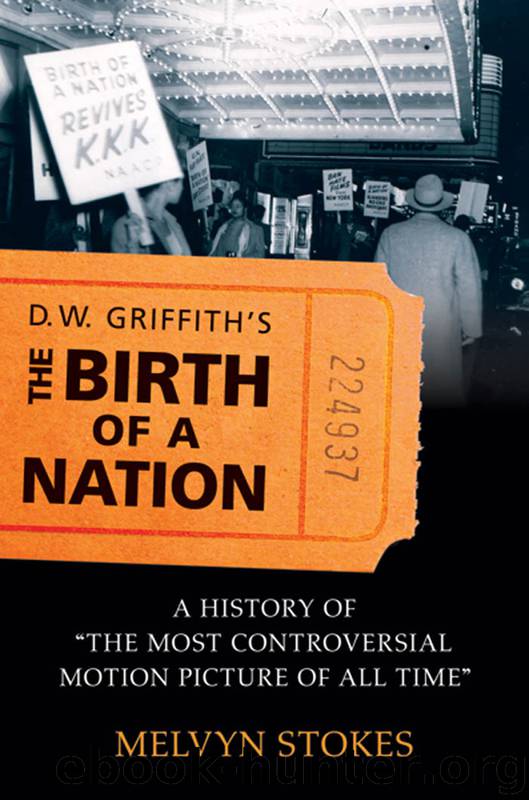D W Griffith's The Birth of a Nation by Melvyn Stokes

Author:Melvyn Stokes [Stokes, Melvyn]
Language: eng
Format: epub
ISBN: 9780195336788
Publisher: Oxford University Press, USA
Published: 2007-05-15T04:00:00+00:00
The Issue of Miscegenation
In the early twentieth century, white Americans tried to shore up the ascendancy of their race by introducing immigration restrictions, first on Oriental entry to the United States, later on the supposedly inferior “new” immigrants from southern and eastern Europe. They also endeavored to preserve the purity of their own race by passing laws against miscegenation:203 between 1887 and 1930 at least forty-one attempts were made to ban interracial marriage in Mid-Atlantic and East North Central states.204 In the South, laws of this type were mainly designed to prevent marriage between blacks and whites. In some Western states, however, they were much more complex, at times banning marriage between whites and Orientals, Indians, and Mexicans.205
The idea of a pure white race can be traced back at least as far as Tacitus. “In the peoples of Germany,” maintained the Roman historian, “there has been given to the world a race untainted by intermarriage with other races … pure, like no one but themselves.”206 Gobineau had also declared his opposition to racial mixing to protect the purity of the “Aryan” race. In the United States during the first half of the nineteenth century, as previously noted, those who regarded themselves as pure-bred Anglo-Saxons had a tendency to look down on Mexicans, whom they regarded as a “mongrel” race through intermarriage with Indians and blacks.207 Yet in the final decades of the century, the confidence of those who regarded themselves as “Anglo-Saxons” was such that for most of the time they could view with equanimity the arrival of European immigrants from a wide variety of national and ethnic origins. So vague was the concept of an Anglo-Saxon race and so confident in its powers of assimilation were those who regarded themselves as members that they regarded the “Melting Pot” as principally a means of producing future Anglo-Saxon citizens. Moreover, so great was their faith in the reproductive powers of the white Anglo-Saxons that some were prepared to argue that relationships between white men and black women would succeed in “white-washing” their descendants and finally erasing all trace of the black race.208
Confidence such as this had been replaced, by the early years of the twentieth century, with feelings of anxiety and trepidation. The Birth of a Nation both shaped and reflected contemporary concerns over racial intermingling. Of the three irredeemably evil characters in The Birth of a Nation, two, as mulattoes, symbolized the dangers of racial mixing: Lydia, the “housekeeper” of Austin Stoneman, whose passion for her is suggested to be the basis for his attempt to impose racial equality on the defeated South; and Silas Lynch, the black lieutenant-governor who attempts to create a black empire of his own and arrange a “forced marriage” with Stoneman’s daughter, Elsie (shots 133–34, 1322, 1346).209 The third villain is Gus, a black, who first tells the white Flora Cameron that he would like to marry her and then, when she runs away, chases her until, panicking, she jumps to her death to escape him (shots 1024–82).
Download
This site does not store any files on its server. We only index and link to content provided by other sites. Please contact the content providers to delete copyright contents if any and email us, we'll remove relevant links or contents immediately.
Call Me by Your Name by André Aciman(20348)
Ready Player One by Cline Ernest(14491)
How to Be a Bawse: A Guide to Conquering Life by Lilly Singh(7360)
Wiseguy by Nicholas Pileggi(5645)
The Kite Runner by Khaled Hosseini(5061)
On Writing A Memoir of the Craft by Stephen King(4847)
Audition by Ryu Murakami(4821)
The Crown by Robert Lacey(4710)
Call me by your name by Andre Aciman(4598)
Gerald's Game by Stephen King(4554)
Harry Potter and the Cursed Child: The Journey by Harry Potter Theatrical Productions(4427)
Dialogue by Robert McKee(4305)
The Perils of Being Moderately Famous by Soha Ali Khan(4156)
Dynamic Alignment Through Imagery by Eric Franklin(4096)
Apollo 8 by Jeffrey Kluger(3618)
Seriously... I'm Kidding by Ellen DeGeneres(3563)
The Inner Game of Tennis by W. Timothy Gallwey(3557)
How to be Champion: My Autobiography by Sarah Millican(3544)
Darker by E L James(3463)
